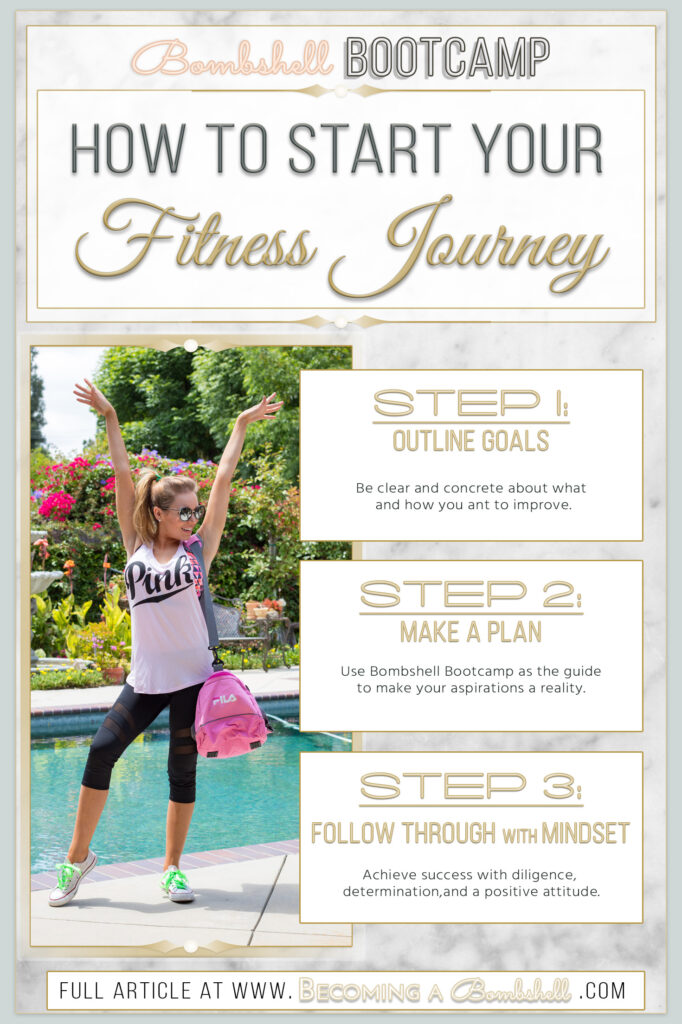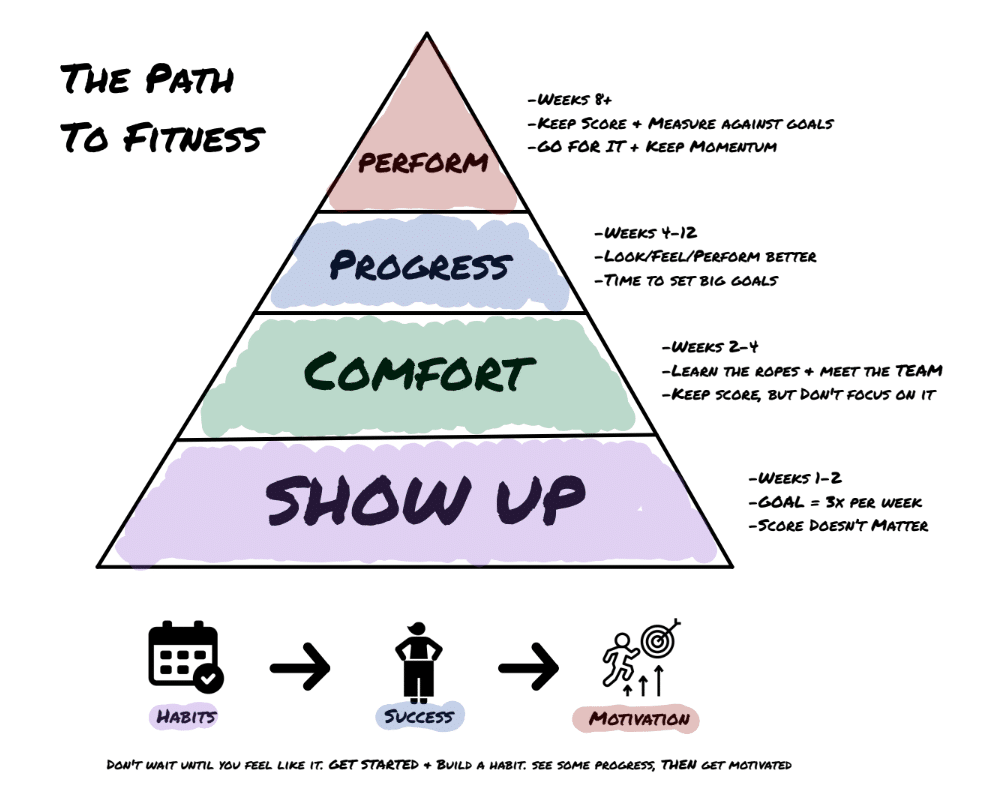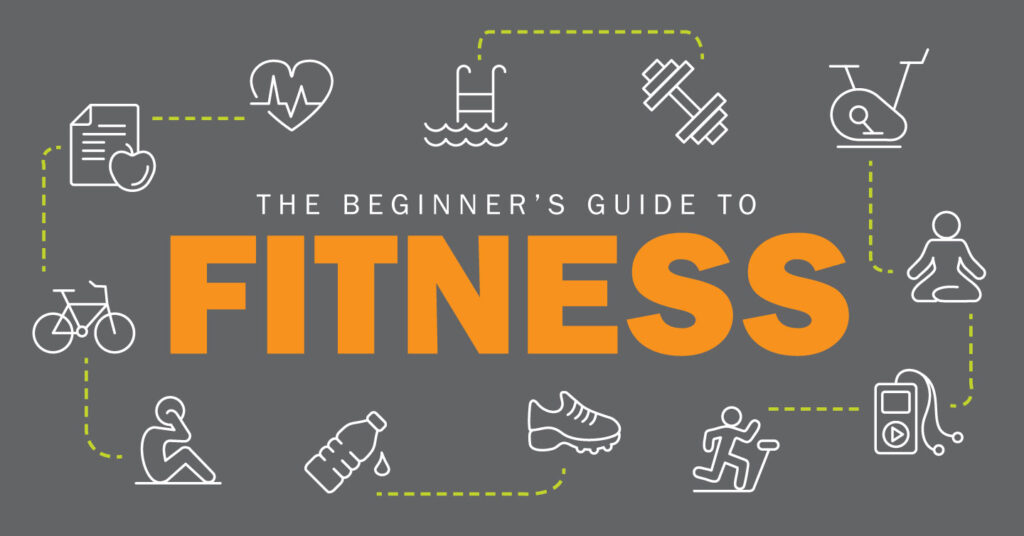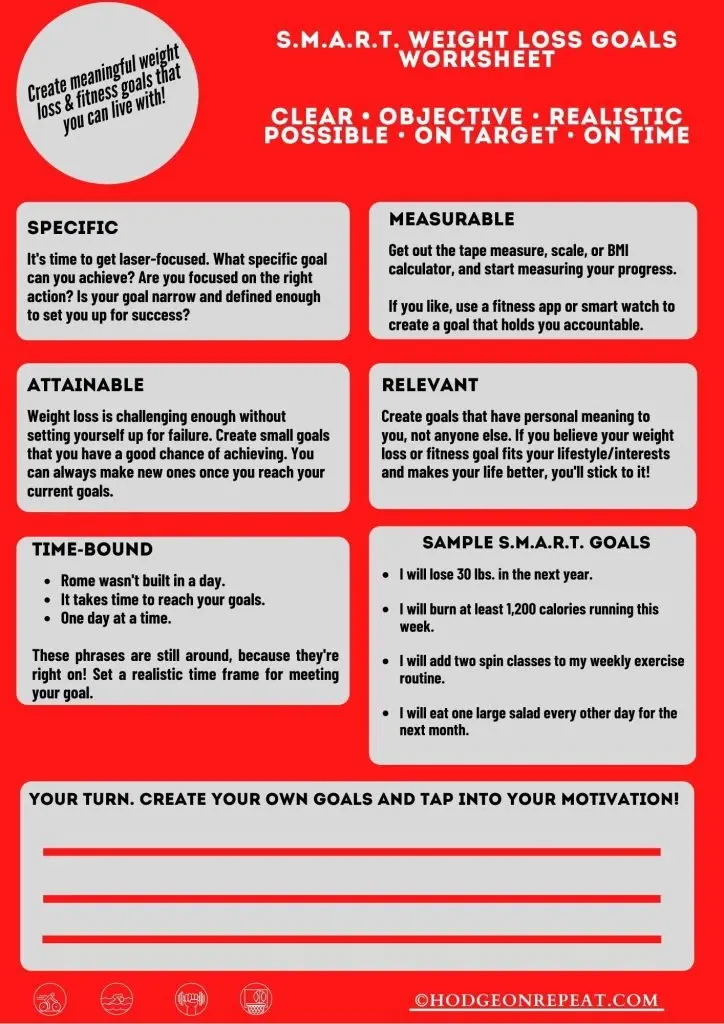Ready to embark on your fitness journey but not sure where to begin? Starting your fitness journey can feel overwhelming, but with the right approach, it can be an exciting and rewarding experience. Whether you’re a complete beginner or looking to get back into shape, this article will guide you through the essential steps to kickstart your fitness journey and help you achieve your health and wellness goals. Say goodbye to excuses and hello to a healthier, fitter you!

This image is property of becomingabombshell.com.
Setting Goals
Identify Your Why
Before starting your fitness journey, it’s important to identify your why. Ask yourself why you want to embark on this journey. Is it to improve your overall health and well-being? Do you want to lose weight or gain muscle? Are you training for a specific event or sport? Understanding your motivations will help you stay committed and focused throughout the process.
Establish Specific Goals
Once you have identified your why, it’s time to establish specific goals. Instead of just saying, “I want to get fit,” be more specific. For example, you could set a goal to lose 10 pounds in three months or run a 5K race in under 30 minutes. By setting clear and tangible goals, you can track your progress and stay motivated.
Set Realistic and Achievable Targets
While it’s important to set challenging goals, it’s equally important to set realistic and achievable targets. If you set the bar too high, you might find yourself getting discouraged and giving up. Take into consideration your current fitness level, lifestyle, and any physical limitations. Set targets that are challenging yet attainable, and celebrate your progress along the way.
Create a Timeline
To keep yourself accountable and on track, create a timeline for your fitness journey. Determine how long you are willing to commit to achieving your goals and break it down into smaller milestones. For example, if you want to lose 20 pounds in six months, set a goal to lose 2-3 pounds per month. Having a timeline will help you stay focused and make adjustments as needed along the way.
Assessing Fitness Level
Body Measurements
Before starting your fitness journey, it’s important to assess your current fitness level. Take body measurements such as weight, body fat percentage, and waist circumference. These measurements will serve as a baseline to track your progress over time.
Cardiovascular Fitness
Assessing your cardiovascular fitness is crucial for determining your overall endurance and aerobic capacity. You can test your cardiovascular fitness by performing activities such as running, cycling, or swimming and measuring your heart rate, breathing rate, and how quickly you recover after exertion.
Strength and Muscular Endurance
Strength and muscular endurance are essential for everyday activities and overall fitness. Assess your strength by performing exercises such as push-ups, squats, and planks. Measure your ability to perform these exercises and note any limitations or areas for improvement.
Flexibility
Flexibility is often overlooked but plays a crucial role in preventing injuries and improving overall mobility. Assess your flexibility by performing stretches that focus on major muscle groups such as hamstrings, shoulders, and hips. Take note of any areas where you feel restricted or tightness.

This image is property of i.ytimg.com.
Designing a Workout Plan
Choose Activities You Enjoy
To set yourself up for success, choose physical activities and exercises that you genuinely enjoy. Whether it’s walking, dancing, swimming, or weightlifting, find activities that make you feel good and keep you motivated. By choosing activities you enjoy, you’re more likely to stick to your workout plan long-term.
Determine Frequency and Duration
Consider your schedule and lifestyle when determining how often and how long you can commit to exercise each week. Aim for at least 150 minutes of moderate-intensity aerobic activity or 75 minutes of vigorous-intensity aerobic activity per week, along with strength training exercises at least twice a week. Remember, consistency is key.
Include Cardiovascular Exercise
Cardiovascular exercise, also known as aerobic exercise, is essential for improving your heart health and increasing endurance. Choose activities such as walking, jogging, cycling, or swimming that elevate your heart rate and make you break a sweat. Aim for at least 30 minutes of moderate-intensity cardio on most days of the week.
Incorporate Strength Training
Strength training helps build muscle, increase bone density, and boost metabolism. Include exercises that target major muscle groups, such as squats, lunges, push-ups, and rows. Start with lighter weights or bodyweight exercises and gradually increase intensity as you gain strength and confidence.
Integrate Flexibility and Mobility Work
Don’t forget to incorporate flexibility and mobility exercises into your workout plan. Stretching and mobility exercises help improve range of motion, prevent muscle imbalances, and reduce the risk of injuries. Include dynamic stretches before your workout and static stretches in your cool-down routine.
Consider Cross-Training
Cross-training involves varying your workouts to include different types of exercises and activities. It helps prevent boredom, reduces the risk of overuse injuries, and enhances overall fitness. Mix up your routine by incorporating activities such as yoga, swimming, cycling, or dance classes to challenge different muscle groups and keep things interesting.
Building a Support System
Find an Accountability Partner
Having an accountability partner can significantly increase your chances of sticking to your fitness journey. Find someone who shares similar goals or interests and can hold you accountable to your commitments. Whether it’s a friend, family member, or coworker, choose someone who will encourage and support you along the way.
Join a Fitness Community or Group
Joining a fitness community or group can provide you with a sense of belonging and motivation. Look for local fitness classes or groups that cater to your interests, such as running clubs, yoga studios, or group exercise classes. Surrounding yourself with like-minded individuals can help keep you motivated and inspired.
Hire a Qualified Personal Trainer
If you’re new to exercise or need guidance and personalized attention, consider hiring a qualified personal trainer. A personal trainer can assess your fitness level, create a tailored workout plan, and provide ongoing support and motivation. They can also ensure you’re using proper form and technique to prevent injuries.
Utilize Online Resources and Apps
In today’s digital age, there are numerous online resources and fitness apps available to support your fitness journey. From workout videos and exercise tutorials to meal planning and tracking apps, these resources can provide guidance, motivation, and accountability at your fingertips. Explore different options and find ones that align with your goals and preferences.

This image is property of thegoldengrahamgirl.files.wordpress.com.
Nutrition and Diet
Assess Current Eating Habits
Before making any drastic changes to your diet, take the time to assess your current eating habits. Pay attention to portion sizes, types of food you consume, and any unhealthy patterns or behaviors. Identifying areas for improvement will help you make sustainable changes to your diet.
Establish a Balanced and Sustainable Diet
A balanced and sustainable diet is essential for supporting your fitness goals and overall well-being. Focus on consuming a variety of nutrient-dense foods from all food groups, including fruits, vegetables, lean proteins, whole grains, and healthy fats. Avoid or limit processed foods, sugary beverages, and excessive alcohol consumption.
Understand Macronutrients and Micronutrients
Macronutrients, including carbohydrates, proteins, and fats, provide the energy your body needs to function properly. Micronutrients, such as vitamins and minerals, are essential for various bodily functions. Educate yourself on the role of macronutrients and micronutrients in your diet and ensure you’re getting a balanced intake.
Practice Portion Control
Portion control is crucial for maintaining a healthy weight and fueling your body appropriately. Pay attention to serving sizes and try to avoid mindless eating. Use smaller plates and bowls, read nutrition labels, and listen to your body’s hunger and fullness cues. Balancing your energy intake with your energy expenditure is key.
Stay Hydrated
Proper hydration is often overlooked but is essential for optimal performance and overall health. Drink water throughout the day, especially during and after exercise. Limit sugary and caffeinated beverages, as they can dehydrate you. Aim for at least eight cups (64 ounces) of water per day, or more depending on your activity level and climate.
Creating a Schedule
Find Time in Your Daily Routine
Finding time for your workouts can be challenging, but it’s important to prioritize your health. Assess your daily routine and identify pockets of time that can be dedicated to exercise. It could be waking up earlier, using your lunch break, or finding time after work. Remember, a little bit of exercise is better than none.
Prioritize Your Workout
Treat your workout as an important appointment that cannot be missed. Schedule it in your calendar, set reminders, and commit to it just like you would any other obligation. By making your workout a priority, you’ll be more likely to follow through and stay consistent.
Schedule Rest Days
Rest days are crucial for allowing your body to recover and prevent overtraining. Schedule regular rest days in your workout plan to give your muscles and mind the chance to rejuvenate. Use these rest days to focus on other self-care activities such as stretching, foam rolling, or practicing mindfulness.
Manage Time Effectively
Managing your time effectively is key to fitting in your workouts and other commitments. Utilize time-management strategies such as prioritizing tasks, breaking them down into smaller steps, and minimizing distractions. This will help create a balance between your workouts and other responsibilities.

This image is property of crossfitlobo.com.
Staying Motivated
Track Your Progress
Tracking your progress is a great way to stay motivated and see how far you’ve come. Keep a fitness journal or use a tracking app to record your workouts, measurements, and other milestones. Celebrate your achievements and use them as fuel to keep pushing forward.
Reward Yourself
Set small rewards for yourself along the way to stay motivated. Treat yourself to something you enjoy when you reach a milestone or achieve a specific goal. It could be a new workout outfit, a massage, or a day off to relax and recharge. Rewards can help keep you excited and focused on your fitness journey.
Find Inspiration
Seek inspiration from others who have achieved similar fitness goals or have overcome challenges. Follow fitness influencers, read success stories, or join online communities where you can connect with like-minded individuals. Surrounding yourself with positive and motivating influences can fuel your own determination and drive.
Stay Positive and Mindful
Maintain a positive mindset and practice mindfulness throughout your fitness journey. Focus on the progress you’ve made rather than dwelling on setbacks. Practice gratitude, positive self-talk, and self-compassion. Remember that fitness is a lifelong journey, and every small step counts.
Adjust Goals as Needed
As you progress on your fitness journey, it’s essential to constantly assess and adjust your goals. Listen to your body and be open to modifying your targets based on your changing needs and circumstances. Be flexible with your goals and embrace the journey, knowing that adjustments are part of the process.
Overcoming Challenges
Identify Potential Barriers
Identify potential barriers that may hinder your progress and develop strategies to overcome them. Common barriers include lack of time, limited access to equipment, or insufficient motivation. By recognizing these challenges, you can create proactive solutions and find alternatives to overcome them.
Develop Strategies to Overcome Obstacles
Once you’ve identified potential barriers, develop strategies to overcome them. For example, if lack of time is an issue, consider incorporating shorter, more intense workouts or finding opportunities for physical activity throughout your day. If motivation is a struggle, create a motivational playlist or enlist the help of a workout buddy.
Seek Professional Help if Necessary
If you’re facing significant challenges or struggling to make progress on your own, don’t hesitate to seek professional help. A healthcare professional, such as a registered dietitian or exercise physiologist, can provide personalized guidance and support. They can help you navigate through any obstacles and ensure your safety and well-being.
Celebrate Small Victories
Celebrate your small victories along the way to stay motivated and boost your confidence. Whether it’s running an extra mile, lifting heavier weights, or making healthier food choices, acknowledge and celebrate your accomplishments. Remember that every step forward, no matter how small, is progress.

This image is property of networkhealth.com.
Ensuring Safety
Consult with a Healthcare Professional
Before starting any fitness program, consult with a healthcare professional, especially if you have any underlying health conditions or concerns. They can provide valuable insights and ensure that you’re starting a safe and appropriate fitness journey based on your individual needs and medical history.
Warm Up and Cool Down Properly
Always include a warm-up and cool-down session in your workouts. Warm up your muscles and joints with dynamic movements, such as arm swings, leg swings, and hip circles, to increase blood flow and prepare your body for exercise. Cool down with static stretches and gentle movements to gradually lower your heart rate and prevent muscle soreness.
Use Proper Form and Technique
Using proper form and technique during exercises is crucial for preventing injuries and maximizing results. If you’re unsure about how to perform a certain exercise, seek guidance from a qualified personal trainer or reputable online resources. Focus on maintaining good posture, engaging the correct muscles, and gradually increasing the intensity or weights.
Listen to Your Body’s Signals
Your body will give you signals when it needs rest or when something doesn’t feel right. Pay attention to any pain, discomfort, or unusual sensations during exercise. If something doesn’t feel right, modify or stop the exercise altogether. Pushing through pain can lead to injuries and setbacks.
Monitoring Progress
Regularly Assess Fitness Level
Periodically reassess your fitness level to track your progress and identify areas that need improvement. Repeat the tests for cardiovascular fitness, strength, endurance, and flexibility that you performed at the beginning of your journey. Compare your results and celebrate the improvements you have made.
Track Strength and Endurance
Monitor your strength and endurance gains by tracking the weights you lift, the number of repetitions you perform, or the time it takes to complete certain exercises. Regularly challenge yourself to increase the intensity or difficulty to continue progressing.
Monitor Body Composition
While weight alone doesn’t tell the whole story, monitoring changes in body composition can be an indicator of progress. Consider using methods such as body fat calipers, circumference measurements, or DEXA scans to track changes in muscle mass and fat percentage.
Observe Changes in Energy Levels and Well-being
Pay attention to how you feel both during and outside of your workouts. Notice any changes in your energy levels, sleep patterns, mood, and overall well-being. Increased energy, improved mood, and enhanced quality of sleep are positive signs that your fitness journey is benefiting you beyond just physical results.
Starting your fitness journey can be both exciting and challenging. By setting clear goals, assessing your fitness level, designing a personalized workout plan, building a support system, focusing on nutrition, creating a schedule, staying motivated, overcoming challenges, ensuring safety, and monitoring progress, you can embark on a successful and fulfilling fitness journey. Remember, it’s a marathon, not a sprint, so be patient, commit to the process, and enjoy the transformative effects of a healthy, active lifestyle.
